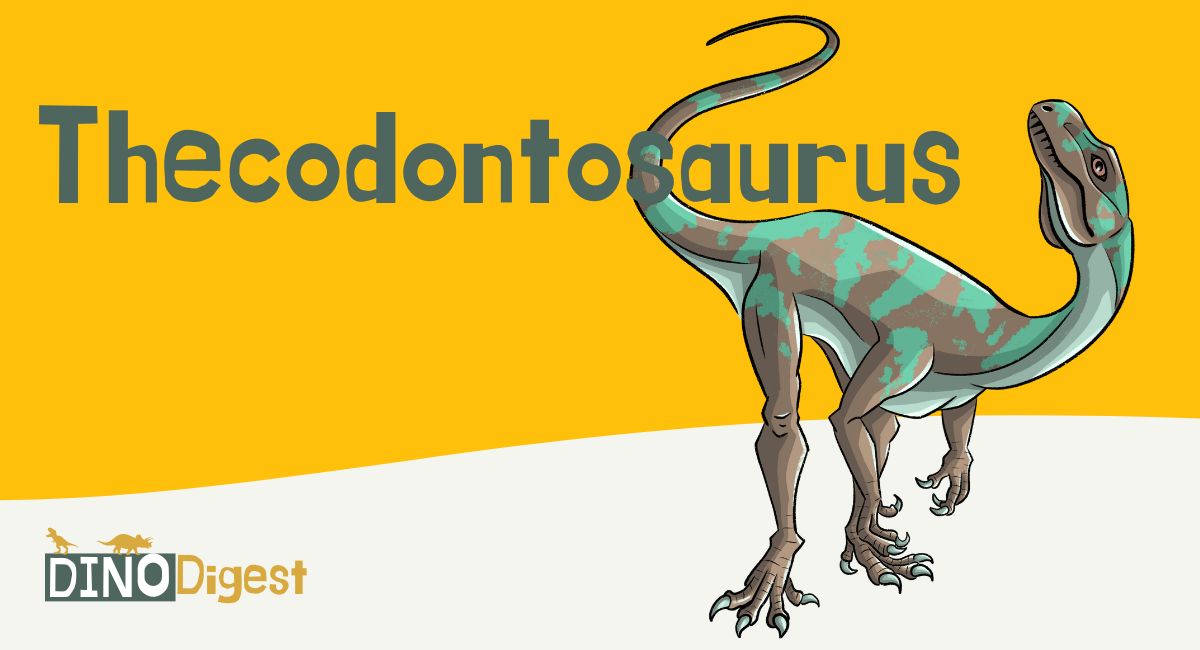The Thecondotosaurs was a small, herbivorous dinosaur that was an early type of sauropod. They were called Prosauropoda because they shared much in common with Jurassic sauropods but were slightly different. These dinos were small, bipedal (they walked on their hind legs), and ate a diet primarily of plants and smaller reptiles.
Table of Contents
Some Quick Facts About the Thecodontosaurus

| Name | Thecodontosaurus (meaning “socket-toothed lizard”) |
| Type of dinosaur | Sauropodomorpha |
| Territory | Grasslands, South Wales, England |
| Size | 4 feet long, 2 feet tall |
| Color | Greenish |
| Interesting Characteristics | A tail that is longer than their entire body, razor-sharp teeth, small arms |
| Diet | Insects, smaller reptiles, plants |
| Major Threats | Natural disasters |
When you think of sauropods, you likely think of the colossal Brontosaurs or the Diplodocidae. But before the enormous sauropods were walking the earth in the Jurassic period, there was the Thecodontosaurus. These early sauropods, or prosauropods, were much smaller and faster than later ones.
They dined on mostly plants and used their powerful hind legs to escape predators. Plus, they were one of the first dinosaurs ever discovered! Keep reading to learn more about this unique and fascinating upper Triassic of southwest England!
When Was the Thecodontosaurus Discovered?
Henry Riley and Samuel Stutchbury found the very first fossils of basal sauropodomorph Thecodontosaurus at the quarry of Durham Down, now known as Bristol in the United Kingdom, in 1834. At first, these fossils looked like typical sauropod dinosaurs, but their unique skull and body structure proved they were a new species of a late Triassic dino.
Many of the original fossils found at the fissure fillings were lost during the German bombing during World War II. Luckily, more fossils of the Thecodontosaurus were discovered in the 1980s, teaching us much more about these unique prosauropods.
Fun fact: the Thecofontosaurus was the fifth dinosaur that earned a name and was among one of the first dino discoveries. Other dinos discovered before this basal sauropodomorph dinosaur were the Hylaeosaurus, Iguanodon, Megalosaurus, and Streptospondylus.
Today, you can find a rich history of the Theocodontosaurus at the University of Bristol.
What Did the Thecodontosaurus Eat?
Many early sauropodomorphs were carnivores (meat-eaters), but the Thecodontosaurus differed. While it had sharp, leaf-shaped teeth, it dined primarily on plants (like a Leptoceratops). The Thecodontosaurus was an herbivore who lived on a diet of twigs, leaves, and seeds.
However, some believed it sometimes ate meat from bugs and smaller reptiles. It has serrated teeth, like the end of a steak knife, that help it chew on tough plants and twigs.
The Theocodontosaurus was small and fast but didn’t use its speed to catch predators. Instead, it used its speed to evade predators to stay safe. While it looked and ran like a fierce predator, the Theocodontosaurus was an herbivore through and through.
What Was Unique About the Thecodontosaurus’ Teeth?

The name Thecondontosaurus means socket-toothed lizard. It earned its name because its teeth were unusual compared to similar sauropods.
While many sauropods had teeth fused to their jaw, the Thecodontosaurus had individual teeth sockets, which was an extraordinary and unique discovery. The description of various fossils made the Thecodontosaurus stand apart from other dinosauria of its time.
What Did The Thecodontosaurus Look Like?
For a sauropod, the Thecodontosaurus was surprisingly small. It weighed 24 pounds, about the same size as a Beagle. It was just shy of 4 feet and stood almost 2 feet tall. If you saw the Theocodontosaurus roaming in your backyard, it would look like a very long dog!
What was also unique about this breed of Saurischia is that it has a surprisingly large head with big eyes and tiny forelimbs, which is unusual for a sauropod. While some of these dinos were small, some were even smaller. Fossils found on various islands were smaller because of dwarfism. Most sauropods of the Jurassic period had sauropod locomotion on all four legs, while the Thecodontosaurus walked on two legs.
How is the Thecodontosaurus Like Other Sauropods?
The Thecodontosaurus is a prosauropod. They share much in common with famous sauropods, like the Brontosaurus, but aren’t technically sauropods. Unlike modern sauropods, the Theocodontosaurus was small, bipedal, and fast. They were the precursor to the gigantic sauropods, like the Brontosaurus. Think of the Theocodontosaurus as the grandfather to sauropods.
Sure, they look different from other sauropods, but if you look closer, they have more in common than you think. Here are some of the most notable traits that the Thecodontosaurus shares with other sauropods of the Jurassic period:
- Herbivores
- Long neck
- Long tail
- Plant-eating serrated teeth
The Thecodontosaurus was a late Triassic dino and was the opening act for more enormous sauropods in the Jurassic period. If it wasn’t for the Thecondotosaurus, we might have never seen the Brontosaurus or the Diplodocidae!

